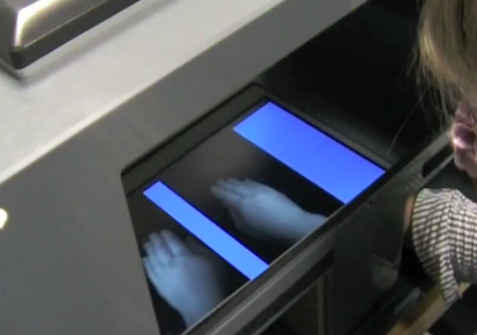'Disappearing Hand Trick' Named Year's Best Illusion

An illusion known as the "disappearing hand trick" earned the top prize at the eighth annual Best Illusions of the Year contest, held May 14 at a meeting of the Vision Sciences Society in Florida. The newly discovered illusion fools the brain into thinking one's hand has vanished.
It works like this: A participant places both hands inside a box and tries to keep them still. Meanwhile, a video of her hands is projected on the top of the box, and the footage is manipulated so that the hands appear to drift slowly toward one other. Instructed to keep her hands from touching, the partcipant moves her hands apart to counteract this apparent drift. What seems like fractions of an inch in the video, however, are several inches in real life: She eventually moves them out of reach of one other without knowing it, because the video continues to display footage of her hands close together.
Next, the image of her right hand disappears, and the experimenter asks her to touch it with her left hand. She reaches toward it, but to her complete shock, her right hand isn't there! (It is farther to the right than she thought, of course.)
As seen in the video, the participant then pulls her hands out of the box, finds them both to be intact, and — in the case of the participant shown — breaks into hysterical laughter.
"It's the combined loss of vision and touch that creates an experience that the hand is missing," said Roger Newport, who discovered the trick with his colleagues Helen Gilpin and Catherine Preston, all of the University of Nottingham in the U.K. "It's very striking, and works for everybody who does it."
Newport said the discovery might have applications outside of the lab, such as for chronic pain sufferers. He told Nature News, "It could change the very way we perceive pain."
Follow Natalie Wolchover on Twitter @nattyover. Follow Life's Little Mysteries on Twitter @llmysteries, then join us on Facebook.
Sign up for the Live Science daily newsletter now
Get the world’s most fascinating discoveries delivered straight to your inbox.
Natalie Wolchover was a staff writer for Live Science from 2010 to 2012 and is currently a senior physics writer and editor for Quanta Magazine. She holds a bachelor's degree in physics from Tufts University and has studied physics at the University of California, Berkeley. Along with the staff of Quanta, Wolchover won the 2022 Pulitzer Prize for explanatory writing for her work on the building of the James Webb Space Telescope. Her work has also appeared in the The Best American Science and Nature Writing and The Best Writing on Mathematics, Nature, The New Yorker and Popular Science. She was the 2016 winner of the Evert Clark/Seth Payne Award, an annual prize for young science journalists, as well as the winner of the 2017 Science Communication Award for the American Institute of Physics.












